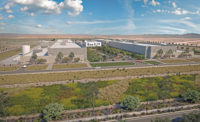
In an industry characterized by fierce competition and risk avoidance, Saunders Construction Inc., Centennial, Colo., is collaborating with its peers in nontraditional ways that would make most commercial contractors squirm.
Consistently ranked by Engineering News-Record as one of the three largest general contractors in Colorado, the 43-year-old firm is forming long-term partnerships with other like-minded companies to increase its reach, push boundaries and realize greater growth.
"To be a $400-million-a-year contractor in this market, you have to be a lot of things to a lot of people," says John Beeble, the firm's CEO and chairman of the board. For Saunders, that means tackling a range of projects, from $500,000 to more than $100 million. It also means taking a different approach to collaboration—one that goes beyond typical, project-specific joint ventures—and opens Saunders up to a new kind of partnering. A little more than a year ago, Saunders approached Heath Construction of Fort Collins, Colo., to discuss a partnership that would capitalize on Heath's local relationships and Saunders' muscle—more manpower, resources and expertise. The partnership is neither a traditional merger nor an acquisition.
"We wanted to be in the Northern Colorado market—and we wanted to be up there, present and local," says Beeble. "Everyone was super high on Northern Colorado [and] we asked ourselves how we could leverage that."
At the same time, Randy DeMario, Heath's president, was looking for an opportunity to grow his $40-million general contracting firm. With an average project size of $3 million, the 37-year-old Heath was comfortably constructing a range of projects from $150,000 remodels up to $12-million projects in the retail, industrial and higher education markets in Northern Colorado. DeMario realized reaching the next level would require considerable time and capital. The two contractors made their 50/50 partnership official last summer, and Heath Construction LLC was born.
"It's been a home run, a win-win all around," DeMario says. "We're still local, which is a very important element and why we've been very successful. [Our partnership] is a different model—much more than buying a company or doing a joint venture. It's been a perfect match to have Saunders stand beside us as we grow."
"We are Randy's business partners; now he has a sister company called Saunders that cares about his success," Beeble adds. "This creates a lot of opportunity for us and for our people."
The partnership, which DeMario says initially moved forward on a handshake, is already garnering projects for the newly established limited liability corporation, including the Galeton Fire Station, the Estes Park Wellness Center and the School of Agriculture Building at Colorado State University. The firm projects a revenue jump to $70 million in 2015.
Saunders has a similar relationship with the Chasse Building Team in the Phoenix market. The Chasse Saunders LLC partnership was formed in 2009 and is currently working on a Morningstar Assisting Living Center in Phoenix. "Our industry doesn't partner very well, but we're finding that this [business model] is a great way to grow and adapt. It's being opportunistic," says Greg Schmidt, president at Saunders.
Deliberate, Calculated Alliances
The firm's collaborative instincts officially took root in 2001 when Saunders became a partner with the Citadel National Construction Group, a consortium of general contractors located in strategic markets from coast to coast. The first of its kind, the Citadel Group was created in 1999 when several large firms from across the country met to discuss best practices and ultimately created a limited liability corporation. Today, the Citadel Group includes seven best-in-class construction firms with combined revenue pushing $3 billion.
"It's a trust-based way of looking at the world, where trust and patience are the keys," says Schmidt.
"There are other peer groups out there, but they haven't taken it to the level of sharing resources that we have," explains Bart Ricketts, CEO of Lease Crutcher Lewis, a 129-year old general contractor and a Citadel partner with offices in Portland, Ore., and Seattle.
For instance, a Citadel-member firm might lend a superintendant to another member's project or be involved at the preconstruction level when a particular expertise is needed. More often than not, if a client decides to build in another market, the local Citadel firm is instrumental in overseeing the project and coordinating expectations. Operational procedures, work practices and reporting and financial systems are outlined in a standard operations manual, and the firms have put together a joint-venture template that can be used if a big project should come along that the partners want to execute. The Citadel Group has built an estimated $750 million in projects since its inception.
"We truly value Saunders [and have a] deep level of trust with them," says Ricketts, who is currently serving a two-year term as Citadel Group president. "They're also a great innovator, always looking for better ways to run their business and structure their projects. We're looking for these good lessons to incorporate in our company."







